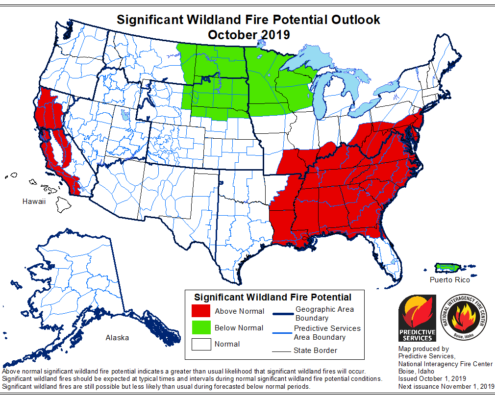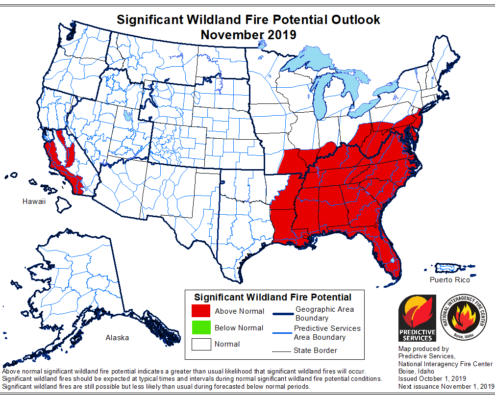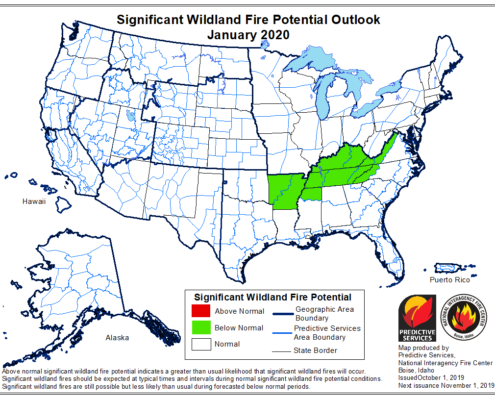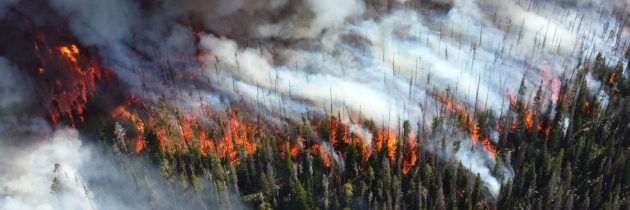Below are summaries from the National Significant Wildland Fire Potential Outlook, provided by the National Interagency Fire Center, for the period of October 2019 through January 2020. The full outlook can be located here which will give more in depth picture of US fire weather projection.
Statistics Year-To-Date:
Year-to-date statistics Number of Fires Acreage Burned 2019 (1/1/19 – 10/01/19) 40,056 4,367,481 2009-2018 – Year-to-Date 50,948 6,250,667 Percentage of 10-year Average 78.62% 69.87%
Source: https://www.nifc.gov/fireInfo/nfn.htm
The table above indicates this season is well below average in both number of fires and total acreage. The previous outlooks suggest a later start for fire season. California in particular could see an increase in fire activity in the Fall with the arrival of Santa Ana, Diablo, Sundowner, and Northwinds. A brief warming period in December through Southern California could also warrant some late starts. The Southeast, which also frequently experiences bi-modal fire seasons, may see a increased fire activity through the outlook period.
Observations in September:
Fire activity in general continues to be below average through September across the entire US. By mid-month, some high elevation locations across the Pacific Northwest, Northern Rockies and Wyoming were already beginning to experience snowfall. Additionally, cooler air moved in creating an early start to the fall in the West. By late month, only Southern California and Arizona remained unusually dry. Though, a tropical moisture plume hit Arizona during the third week of the month relieving some larger fires. In the East, much warmer and drier than average conditions continued across Texas through the beginning of the month. However, tropical storm Imelda moved on shore near Houston and produced more than 42 inches of rainfall as it drifted north across the state. The central and southern Appalachians and Alabama became very dry. Large areas of drought began to develop from Maryland south to the Florida Panhandle, which will likely continue over the next months.
Wildland Fire Outlook for October-November:
In Alaska, current fires will likely continue burn/smolder until the ground begins to freeze, which could be into October with the current weather patterns. Below Normal significant large fire potential is expected across eastern Wyoming and western South Dakota in October. Outside of these areas including Colorado can expect Normal significant large fire potential during the outlook period.
In the Southeast US, Above Normal significant large fire potential is expected through November, as drier and warmer than average conditions continue. In Northern California, Above Normal significant large fire potential is expected across Sacramento Valley and Foothills, the entire Bay Area, the Mid Coast from Clear Lake south, and along the western slopes of the Cascade-Sierra range in October. The general outlook for October is for drier and warmer than average conditions. Areas from the lower western Cascade-Sierra slopes to coastal areas from Clear Lake southward have Above Normal significant fire potential due to the fuel conditions and expected weather. Unless the region sees a decrease in rainfall which is unexpected, Normal significant fire potential is expected through November to January 2020.
In Southern California, Above Normal significant large fire potential is expected in the middle elevations and East Wind-prone areas. Other locations can expect Normal significant large fire potential. Lack of rain and strong drying conditions in September, will make both live and dead fuels ready to burn during hot and windy conditions. Some rain is expected from October to November, but will not be enough to mitigate the large fire potential.

Latest Significant Wildland Fire Potential Outlook for October, 2019

Latest Significant Wildland Fire Potential Outlook for November, 2019
Wildland Fire Outlook for December:
Normal expected significant fire potential is likely for Northern California. Moisture moving into Southern California could slightly reduce large fire potential in December.

Latest Significant Wildland Fire Potential Outlook for December, 2019
Wildland Fire Outlook for January:
Increasing passing weather systems will negate the large fire potential to continue in January for the Southeast. Normal fire potential will persist throughout California.

Latest Potential Wildland Fire Outlook for the Month of January, 2020
Source: NIFC Predictive Services




